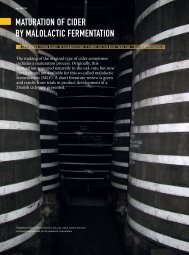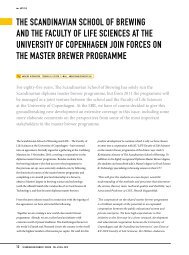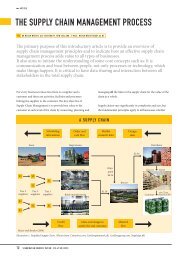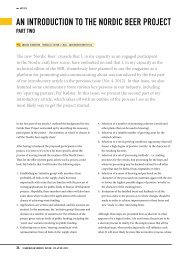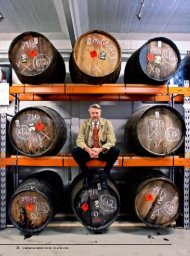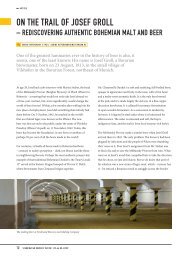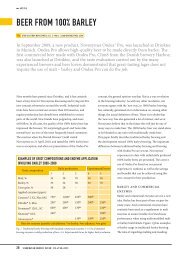The beer of The Danish GolDen aGe - Scandbrewrev.dk
The beer of The Danish GolDen aGe - Scandbrewrev.dk
The beer of The Danish GolDen aGe - Scandbrewrev.dk
You also want an ePaper? Increase the reach of your titles
YUMPU automatically turns print PDFs into web optimized ePapers that Google loves.
<strong>The</strong> <strong>beer</strong> <strong>of</strong> <strong>The</strong> <strong>Danish</strong> <strong>GolDen</strong> <strong>aGe</strong><br />
drawn up on paper by a certain Master Builder Blom. <strong>The</strong>se<br />
detailed drawings, combined with Brøndum’s process descrip-<br />
tions, give an excellent and complete insight into Coopenha-<br />
gen’s golden age <strong>of</strong> ale brewing, at the time where this national<br />
style <strong>of</strong> brewing reached its qualitative culmination. Since<br />
then, the palates <strong>of</strong> the <strong>beer</strong> drinking people <strong>of</strong> Denmark have<br />
been flooded with masses <strong>of</strong> uninspiring imitation brew. For<br />
a long period <strong>of</strong> time, the bottom-fermented, continental <strong>beer</strong><br />
types dominated, but recently the top-fermented ales, inspired<br />
by Belgian, British, and American brews, have provided new<br />
energy to the <strong>Danish</strong> 170-year-old imitation tradition. That<br />
the original <strong>Danish</strong> ale has been type casted as ‘hvidtøl’ is due<br />
to combination <strong>of</strong> several factors:<br />
• <strong>The</strong> introduction <strong>of</strong> taxes on <strong>beer</strong><br />
• An early enthusiasm among brewers for the terms<br />
‘white malt’ and ‘white malt kiln’<br />
• <strong>The</strong> ale breweries’ doubts about the development<br />
• And not least, a number <strong>of</strong> historians’ barely<br />
concealed and political excitement for the <strong>Danish</strong><br />
industrialisation’s influence on the brewing trade and<br />
its bottom-fermented products.<br />
<strong>The</strong> economic VicTor – and <strong>The</strong> myTh oF <strong>The</strong><br />
subsTandard PasT<br />
Why this massive and almost stubborn attempt to equate<br />
the early 19th century top-fermented <strong>beer</strong> with today’s weak<br />
products <strong>of</strong> ‘hvidtøl’ by so many historians? <strong>The</strong> phrase: ‘J.C.<br />
Jacobsen’s father had a pale ale brewery in Brolæggerstræde’,<br />
occurs, as mentioned before, again and again.<br />
<strong>The</strong> only rational explanation must be found in the spirit <strong>of</strong><br />
the time in which the many statements took place. Here, I<br />
16 SCANDINAVIAN BREWERS’ REVIEW . VOL.65 NO.4 2008<br />
naturally mean the long period <strong>of</strong> the 19th century where<br />
the Bavarian <strong>beer</strong> revolution had happened and the<br />
bottom-fermented lager was considered to be at the definitive<br />
top <strong>of</strong> the history <strong>of</strong> <strong>beer</strong>’s league table. On the basis <strong>of</strong><br />
this conviction, when the near historical background for<br />
this universally triumphant <strong>beer</strong> type was to be explained,<br />
being at the same time an outstanding <strong>Danish</strong> export hit in<br />
the apparel <strong>of</strong> Carlsberg’s labels, it was probably tempting,<br />
in spite <strong>of</strong> several historical sources, to belittle the old<br />
types <strong>of</strong> ale and equate them both with the filthy, preindustrial<br />
setting <strong>of</strong> old Copenhagen, on the one hand, and<br />
the product that the top-fermented <strong>Danish</strong> <strong>beer</strong> later had<br />
developed into, on the other hand.<br />
In the 19th century’s early years, they had in reality accomplished<br />
to brew <strong>beer</strong> in a quantity that provided an efficient<br />
utilisation <strong>of</strong> raw materials. <strong>The</strong>y had developed the<br />
kiln technology to a point where a more gently treated and<br />
paler malt gave an increased extract during the brewing<br />
process. <strong>The</strong>oretical knowledge combined with temperature<br />
and extract measurings actually provided the brewer<br />
with a completely new popular scientifically grounded<br />
guarantee <strong>of</strong> rational actions during brewing and fermentation.<br />
<strong>The</strong> myTh oF <strong>The</strong> Weak ale<br />
When being occupied with guessing and making tentative<br />
calculations <strong>of</strong> the strength <strong>of</strong> the historical <strong>Danish</strong> ale,<br />
from the renaissance until the end <strong>of</strong> the 18th century, the<br />
conclusion has been that throughout the years, the <strong>beer</strong><br />
managed to present a large palette <strong>of</strong> alcohol levels, cereal<br />
and kiln specific types <strong>of</strong> malt aromas, levels <strong>of</strong> acidity, and



